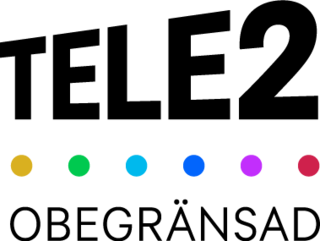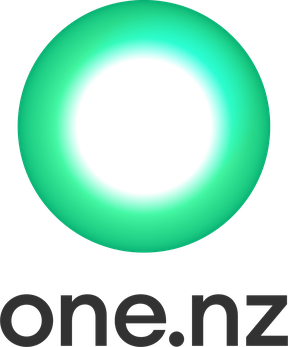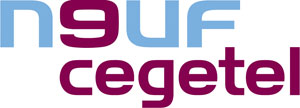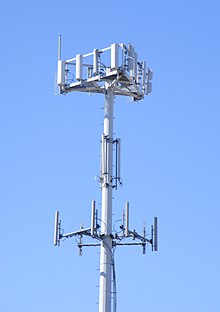Telecommunications in France are highly developed. France is served by an extensive system of automatic telephone exchanges connected by modern networks of fiber-optic cable, coaxial cable, microwave radio relay, and a domestic satellite system; cellular telephone service is widely available, expanding rapidly, and includes roaming service to foreign countries.
The Universal Mobile Telecommunications System (UMTS) is a third generation mobile cellular system for networks based on the GSM standard. Developed and maintained by the 3GPP, UMTS is a component of the International Telecommunication Union IMT-2000 standard set and compares with the CDMA2000 standard set for networks based on the competing cdmaOne technology. UMTS uses wideband code-division multiple access (W-CDMA) radio access technology to offer greater spectral efficiency and bandwidth to mobile network operators.

3G is the third generation of wireless mobile telecommunications technology. It is the upgrade to 2G, 2.5G, GPRS and 2.75G Enhanced Data Rates for GSM Evolution networks, offering faster data transfer, and better voice quality. This network was superseded by 4G, and later by 5G. This network is based on a set of standards used for mobile devices and mobile telecommunications services and networks that comply with the International Mobile Telecommunications-2000 (IMT-2000) specifications set by the International Telecommunication Union. 3G is used in wireless voice telephony, mobile Internet access, fixed wireless Internet access, video calls and mobile TV.

A cell site, cell phone tower, cell base tower, or cellular base station is a cellular-enabled mobile device site where antennas and electronic communications equipment are placed to create a cell, or adjacent cells, in a cellular network. The raised structure typically supports antenna and one or more sets of transmitter/receivers transceivers, digital signal processors, control electronics, a GPS receiver for timing, primary and backup electrical power sources, and sheltering.

A mobile virtual network operator (MVNO) is a wireless communications services provider that does not own the wireless network infrastructure over which it provides services to its customers. An MVNO enters into a business agreement with a mobile network operator to obtain bulk access to network services at wholesale rates, then sets retail prices independently. An MVNO may use its own customer service, billing support systems, marketing, and sales personnel, or it could employ the services of a mobile virtual network enabler (MVNE).

Tele2 AB is a provider of mobile and fixed connectivity, telephony, data network services, TV, streaming and global Internet of Things services, amongst others, to consumers and enterprises. It is headquartered in Kista Science City, Stockholm, Sweden. It is a major mobile network operator in Sweden, Estonia, Latvia and Lithuania. The company initially founded Tele2 Russia, but later sold all its operations, only leasing the use of its brand name.

One New Zealand Group Limited, stylised as One NZ, is a New Zealand telecommunications company. One NZ is the largest wireless carrier in New Zealand, accounting for 38% of the country's mobile share market in 2021.
Xfera Móviles, S.A.U., d/b/a Yoigo, is the fourth-largest mobile network operator in Spain and a subsidiary of the Spanish telecommunications company Grupo MásMóvil. Yoigo has a licence and its own cellular network for GSM/2G, UMTS/3G and LTE/4G technologies, and a national roaming agreement for usage of the 2G, 3G and 4G networks of Orange and Movistar.
Bouygues Telecom is a French mobile phone, Internet service provider and IPTV company, part of the Bouygues group. It is the third oldest mobile network operator in France, after Orange and SFR, and before Free Mobile, and provides 2G GSM, 3G UMTS, 4G LTE and 5G NR services. Its headquarters, designed by Arquitectonica and opened in 2011, is located at the border of Paris and Issy-les-Moulineaux near the River Seine.

Neuf Cegetel was a French wireline telecommunications service provider and a mobile virtual network operator (MVNO). It offered various telecommunications services to consumers, enterprises and wholesale customers, ranking second in the country in annual revenues. It was legally established in 2005 following the completion of the merger between Neuf Telecom and Cegetel. As of June 2008, the company became a wholly owned subsidiary of SFR, and the brand disappeared commercially.

Vodacom Tanzania Limited is Tanzania's leading cellular network company. As of December 2020, Vodacom Tanzania had over 15.6 million customers and was the largest wireless telecommunications network in Tanzania. Vodacom Tanzania is the second telecom company in Africa, after Vodacom, to switch on its 3G High-Speed Downlink Packet Access (HSDPA) which was available only in Dar Es Salaam in early 2007.

Hutchison 3G Enterprises S.A.R.L., trading as 3 (Three) and Hutchison 3G, is the owner of several originally UMTS-based mobile phone networks and broadband Internet providers, which operate in Hong Kong, Macau, Austria, Denmark, Indonesia, Ireland, Italy, Sweden, and the United Kingdom.

2degrees is a New Zealand telecommunications provider. Its mobile network launched on 4 August 2009 after nine years of planning. 2degrees offers prepaid and pay-monthly mobile services, as well as fixed-line phone and broadband services. 2degrees is the third-largest wireless carrier in New Zealand, with 1.3 million subscribers as of July 2015.
Free Mobile S.A.S. is a French telecommunications company, subsidiary of Free S.A.S. that provides wireless Internet to consumers in France. It was the fourth mobile network operator to obtain a metropolitan French 3G license in 2009. It also obtained a 4G license in 2011.
EE is a British telecommunications company. It is the flagship consumer brand of the BT Group, taking over from the BT brand itself. EE is the second-largest mobile network operator in the United Kingdom, with 21.2 million customers as of September 2022.

ip.access Limited is a multinational corporation that designs, manufactures, and markets small cells technologies and infrastructure equipment for GSM, GPRS, EDGE, 3G, 4G and 5G. The company was acquired by Mavenir in September 2020.
3G mobile telephony was relatively slow to be adopted globally. In some instances, 3G networks do not use the same radio frequencies as 2G so mobile operators must build entirely new networks and license entirely new frequencies, especially so to achieve high data transmission rates. Other delays were due to the expenses of upgrading transmission hardware, especially for UMTS, whose deployment required the replacement of most broadcast towers. Due to these issues and difficulties with deployment, many carriers delayed acquisition of these updated capabilities.

Airtel India commonly known as Airtel, is the second largest provider of mobile telephony and third largest provider of fixed telephony in India, and is also a provider of broadband and subscription television services. The brand is operated by several subsidiaries of Bharti Airtel, with Bharti Hexacom and Bharti Telemedia providing broadband fixed line services and Bharti Infratel providing telecom passive infrastructure service such as telecom equipment and telecom towers. Currently, Airtel provides 5G, 4G and 4G+ services all over India. Currently offered services include fixed-line broadband, and voice services depending upon the country of operation. Airtel had also rolled out its VoLTE technology across all Indian telecom circles.
Vodafone Australia is an Australian telecommunications brand providing mobile and fixed broadband services. Vodafone’s mobile network covers more than 23 million Australians, and Vodafone has commenced the rollout of its 5G mobile network. Vodafone NBN fixed broadband services are available in capital cities and selected regional centres. Vodafone is the third-largest wireless carrier in Australia, with 5.8 million subscribers as of 2020.












